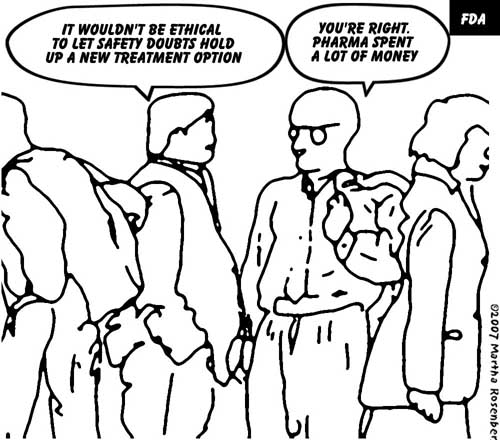“Trust me” used to be the punch line about how a certain obscenity is uttered by Hollywood agents.
It also used to govern pharmaceutical conflicts of interest policies at hospitals, universities, medical schools and scientific journals about doctors’ and researchers’ financial links.
But pharma-related conflicts of interest (COI) at Harvard and other universities, medical journals, professional groups and at the FDA itself have ushered in a kind of disclosure fever. In addition to the Physician Payment Sunshine Act which requires drug and device makers to report physician payments yearly, medical schools are starting to reject industry money that traditionally funded Continuing Medical Education (CMEs).
And it’s about time.
This week, the New York Times‘ Duff Wilson reports Alan Schatzberg, MD, former president of the American Psychiatric Association and Charles Nemeroff, MD, chairman of psychiatry at the University of Miami medical school, wrote an entire textbook funded and directed by drug giant GSK called Recognition and Treatment of Psychiatric Disorders. In May, the duo sat side by side, beaming, at the APA’s annual meeting in New Orleans, as they signed another book they co-wrote, Textbook of Psychopharmacology, even as the meeting’s daily newspaper reported Schatzberg’s links to Eli Lilly, GSK, Merck, Pfizer, Forest, Takeda, Sanofi-Aventis and eight other companies.
Both psychiatrists were investigated by Congress and stripped of National Institutes of Health (NIH) grants. But in June, Nemeroff colleague Thomas Insel, MD, director of the National Institute of Mental Health (NIMH), assured University of Miami officials Nemeroff could still pull federal grant money, according to the Chronicle of Higher Learning.
The pediatric depression expert, Joan Luby, MD was heavily quoted in the New York Times magazine’s August article “Can Preschoolders be Depressed?” despite her undisclosed ties to AstraZeneca and other pharma companies. In the March Archives of General Psychiatry she writes that she didn’t previously disclose ties “because they were not relevant to the subject of the article.”
And Harvard’s, Paul Ridker, MD who put everyday use of statins for people with no heart disease on the map is co-patent holder/inventor of the C-reactive protein (CRP) test which “proves” Crestor’s effectiveness. He apologized to JAMA readers in 2006 for an incomplete financial disclosure for an article about cardiovascular clinical trials. He thought he only had to report funding for the “study at hand” and had omitted mentioning funding from AstraZeneca, Bayer, Novartis, Roche, Sanofi-Aventis and five other pharmaceutical companies.
Only a few years ago, top medical journals ran Why Our Drug Is Best studies written unabashedly by manufacturers. (And 12 years ago the top advertised drugs were Trovan, and Meridia, now withdrawn and Singulair and Evista, heavily restricted.) Then, ghostwriting took over — with pharma getting doctors to “author” pre-written content — and almost none of it was retracted after Congressional investigations.
Now journals comply with conflicts of interest but still have a few tricks up their sleeve.
1) Omnibus disclosure. All of a study’s authors are listed with all the pharma links in one block of solid type. Who goes with whom? You’ll never know — but the author with no links sure isn’t happy about shared guilt.
2) Initials. “R.L.T. has consulted for Merck” is set in 8 point type at the end of the article. Will readers return to the study’s start, five pages ago where there are eight authors, four with first names that begin with R?
3) Disclosures You Have To Work For. COIs of CME faculty are often given online but the information is tucked away in a pull-down, scroll menu. It is user-unfriendly like the drug side-effects found on the scrolling ads on the same site.
4) One Disclosure is Enough. When a previous article is cited in journal letters sections, the author disclosures are said to “be found with the original article.” Surely you have that issue, published four months ago, on your desk.
5) Protective Coloring. Disclosures of drug company links are embedded between government grants and charitable foundations. Government grants and charitable foundations are not conflicts of interest — though some say taking government money along with industry should be.
6) Paying Customers Only. 20 million citations of medical literature appear on the US National Library of Medicine web site. Many have author’s institutions and email. But do the abstracts show COIs? Not unless you’re a paid subscriber. Password, please.
7) Paying Customers Only…Even When You Are Reading A Hard Copy. In hard copies of the August 5 New England Journal of Medicine, the disclosures of authors of “Suicide-Related Events in Patients Treated with Antiepileptic Drugs” are absent and said to be found with the “full text” of the article at NEJM.org.
When we asked Karen Pedersen Buckley, NEJM manager of media relations, why disclosure information about doctors who challenge an 2008 FDA warning ((FDA warned about seizure drugs’ suicide side effects. The authors largely find the drugs safe.)) were not available in the journal’s hard copy, she said the web site was being redesigned. “We hope that many of our readers will have access to the full text and disclosure forms through an institutional subscription at their hospital, university or library,” she added.
And for those who don’t? Trust us.











